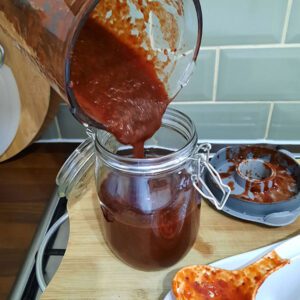Homemade Chamoy sauce is going to be your new best friend! It’s got so much going on, you’ll want to use on everything!
Estimated reading time: 10 minutes
Table of contents
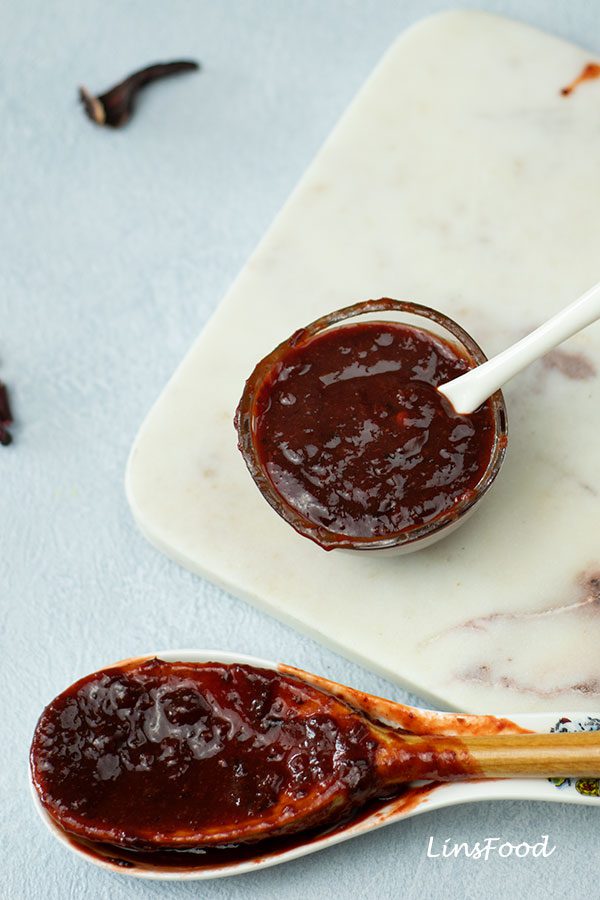
What is Chamoy?
Chamoy started life in Mexico in the early 70s as a sauce with sweet, sour, salty and a touch spicy flavours. It’s not really a hot sauce, as it’s not traditionally spicy.
It’s a sauce that’s mass produced and sold everywhere in Mexico and used as a condiment on a variety of foods, most notably on fruit salads. But more of this later.
Not long after, the same company introduced the powdered version, known as Chamoy Candy Chili Powder. This powder, bears a huge similarity to li hing mui powder, sold in Asia and most certainly in Hawaii (see below, on the origin of Chamoy).
But today’s article is all about the Mexican Chamoy sauce.
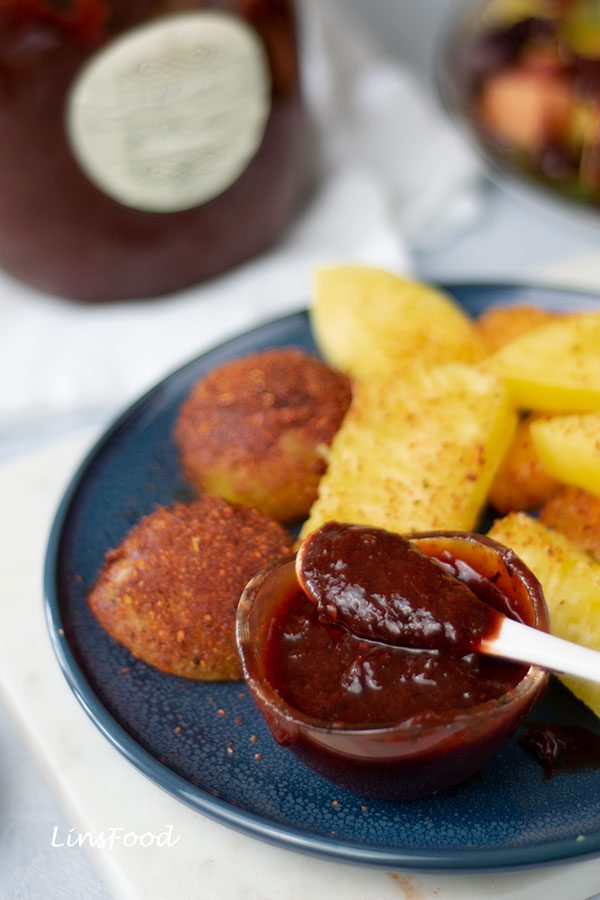
Origin
Chamoy is believed to owe its origin to East Asia, most notably China or Japan. Given its sweet and sour nature, I can totally believe that.
There are a couple of theories explaining how it came about. Some food historians believe that chamoy, with its super tangy flavours was heavily influenced by the Japanese umeboshi, that pickled plum you see in the image below.
Others believe that the word chamoy is a derivation of the Cantonese word see-mui, or even the Hokkien word kiam-mui. Both these (and li hing mui, as it’s also called) refer to a type of preserved sour and salty plum (image below) that’s eaten as a snack in China and many parts of Asia where there are sizeable Chinese immigrants. Like Hawaii, the Philippines, Singapore and Malaysia.
So it’s something I grew up eating. They were cheap and incredibly moreish, I almost always had a packet in my bag! They also help with travel sickness. And since I suffered greatly from it as a child and even now, I never went without. Even today, I always have some as I step on a plane!

Chamoy Recipe
Homemade Chamoy is very, very easy to make, and honestly, tastes so much better than anything out of a bottle. I’ve tried a few Mexican brands, including the chamoy brand, Dulces Miguelito, and I can tell you, your homemade one is definitely going to be better!
All we do is:
- dry toast the chillies for 2-3 minutes and soak them in hot water
- simmer the fruit and dried hibiscus flowers and chillies for a few short minutes
- leave to soak for 20 minutes
- blend everything, taste and adjust seasoning
- cool to room temperature, then store in the fridge
That’s all there is to it.
What is Chamoy Made of?
Depending on where you live, most, if not all, of the ingredients are going to be fairly easy to come by. This is especially if you are already into Mexican cooking and if you receive my chilli newsletters.
To make chamoy at home, we need:
- dried hibiscus flowers (flor de Jamaica)
- dried fruit
- dried chillies (chili peppers)
- tajín
- sugar
- optional salt
- lime juice
- water
Let’s take a look at some of them individually.
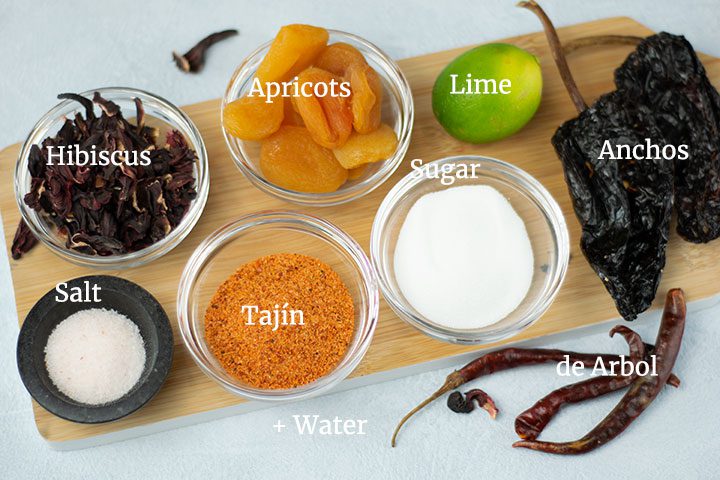
Dried Hibiscus Flowers
There are over 200 species of hibiscus flowers, not all of them edible. The one we use in making chamoy is the roselle (Hibiscus Sabdariffa), also known as flor de Jamaica (pronounced ha-MY-ka) and Karkadé.
It’s a dark burgundy colour, and what is interesting is that it’s not the flower that we are consuming, but the sepal or calyx. But that’s a post for another day, methinks.
You ought to be able to find dried roselle in health food stores, and most definitely online, if you are in the UK, Australia and North America. Besides a Mexican food store, naturally.
Here is my global Amazon affiliate link for organic flor de jamaica.
Hibiscus flowers substitute: dried cranberries are your best bet.

Dried Fruit
Some sort of dried fruit is a must when making chamoy. The most traditional is dried apricots and oftentimes also prunes.
Some people also use raisins and peaches, and this is something you can experiment with once you’ve made it the first time.
I prefer sticking with just apricots when making this tangy Mexican sauce.
Dried Chillies
Chamoy isn’t traditionally spicy, it only has a hint of heat. So to that end, the dried chillies we use tend to be mild, with a tiny amount of something spicy.
I tend to use anchos when making chamoy for the simple reason that I’m a huge fan of their deep, raisin-y flavour. But you can also use pasilla or guajillo, whatever you can get.
Then for that little bit of heat, I add 2-3 chiles de arbol (chilli de arbol in the UK).
Some people just use chilli powder, but I think whole dried chillies give you a much better flavour.
Tajín
Tajín is a Mexican spice blend of dried red chillies, dehydrated lime juice, citric acid and sea salt. The original Tajín is salty, very tangy and with just a hint of heat.
I have a homemade tajín recipe here, if you are interested, but you should very easily be able to find it online. And as usual, here is my Amazon affiliate link if you fancy getting it.
Tajín adds even more oomph to chamoy, increasing its salty and tangy quotient.

Sugar
There is a strong sweet element to the traditional chamoy. Some people use brown sugar for this, but I prefer top keep it clean and use white sugar. Brown sugar adds a cloying sweetness to recipes that I’m not a huge fan of and use it only when necessary in my kitchen.
You can also reduce the amount of sugar, if that’s a concern. Start off with just 1 tablespoon, taste and go from there.
Lime juice
Lime juice adds more tartness and a touch of citrus. You definitely want it because, like I always say, lime juice makes everything taste better!
And fresh lime juice is always the way. What kind of limes? It really doesn’t matter.
Salt
One of the identifying characteristics of chamoy is that it’s salty. This is already provided by the fairly generous amount of tajín that we use. I suggest you blend all your ingredients without the salt.
Then, while your sauce is still in the blender, taste it and adjust the seasoning. Add salt, more sugar or more lime juice and run the blender again to mix thoroughly.
Water
How much water you use in blending your chamoy is up to you, depending on how runny you’d like it to be.
I start off with 2 cups of water, and add more if I fancy a runnier sauce.
This water is going to be your soaking water, by the way. And that brings me to my next point.
The soaking water from the chillies is going to be on the bitter side. Not many people are keen on this, me included. So because of that, I soak the chillies separately and only use the water from soaking the hibiscus flowers and dried fruit for blending.
If you don’t have a problem with using the bitter chilli water, then by all means, add the chillies to the same saucepan as the flowers and fruit to soak together.
Is Chamoy the same as Tajín?
This is a question I get asked quite often when I talk about chamoy to my friends and students. Simple answer is no, chamoy is not the same as tajín.
One is a fruity, tangy and salty sauce while the other is a tart powder. The brand Tajín. also makes chamoy sauce, if you ever want to actually buy it instead of making it. But trust me, homemade is far more superior.
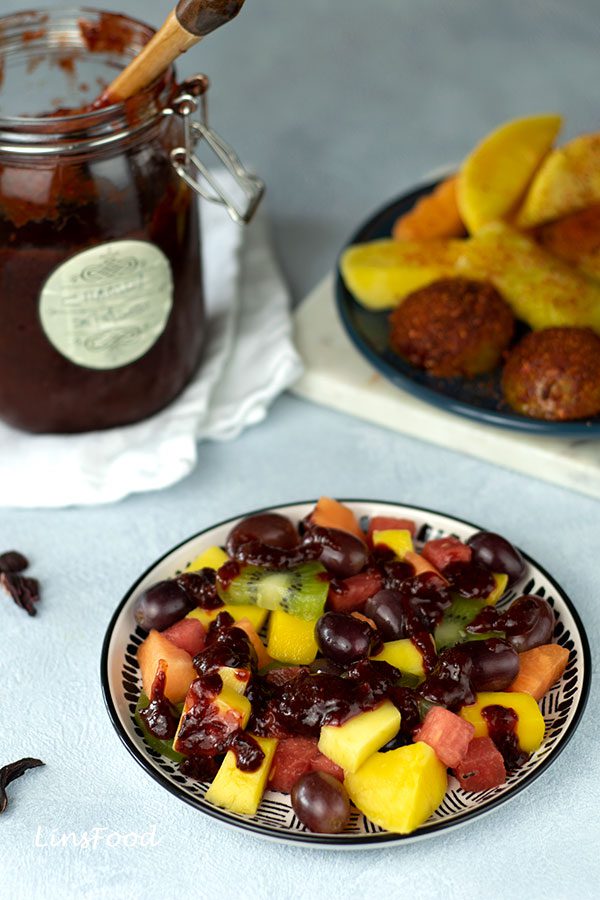
How to use Chamoy?
In Mexico, you’d be hard pressed not to see a Chamoy vendor on every street corner, serving it up with fruit cups, whether the sauce drizzled all over, or the powder sprinkled on fruit.
Let’s take a look at the different ways we can use Chamoy.
Fruit
Fruit cups topped with chamoy sauce are a way of life in Mexico. Just like I grew up eating fruit sprinkled with the very tart ground plum powder, a treat I still love.
So you could chop up some fruit like apples, mango, pineapple, watermelon, peaches, pear, papaya and oranges, and serve them up on a huge platter or individual bowls. Then drizzle your homemade chamoy all over, reserving some on the side for top ups.
Vegetables
Chamoy also makes great dip for crudités. So slice some vegetables like cucumber, jicama, carrots and celery and serve them up with a bowl of this bold, Mexican sauce.
Drinks
Mangonada is a traditional Mexican mango slushy that’s spiked with Chamoy. It is incredibly satisfying with its strong flavours. Perfect on hot days, and recipe coming real soon! I have all the photos done, I just need to find the time to write it up!
It’s also become quite fashionable to make cocktails and mocktails with a little chamoy in the mix or on the glass rim. Look out for a recipe or two in the coming weeks, I just need my thinking cap on.

Cold Desserts
In Mexico, you’ll also find vendors selling cold treat drizzled with chamoy, in the form of popsicles (paletas), shaved ice (raspados) and even ice cream (helados).
So you could do this too. Remember the mango slushies I mentioned above? I make mango and pineapple popsicles with chamoy, and my kids absolutely love them!
Cooking Ingredient
I also use it as a cooking ingredient to add depth to stews and in traybakes. It also makes a great barbecue sauce, on its own or with other ingredients.
How to Store Homemade Chamoy?
I tend to store it in an airtight container (a glass jar), in the fridge and use it within a month. But you can also freeze it for up to 3 months. Just defrost on the kitchen counter and use as needed.
And there you go, more than you probably wanted to know about chamoy, the sweet, sour and salty Mexican sauce! Let’s get our aprons on!
If you enjoy the recipe, drop me a comment and let me know. And if you are feeling like a star, don’t forget that 5-star rating! Thank you!
If you make this recipe, post it on Instagram and tag me @azlinbloor.
Lin xx
More Latin American Recipes



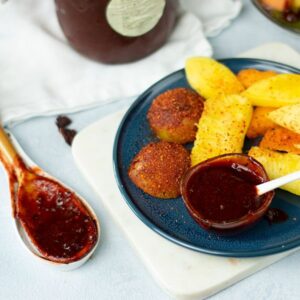
Homemade Chamoy Sauce Recipe
Equipment
- 1 medium saucepan
- bowls
- scissors
- kettles
- slotted spoon
- Blender
- jars to store totalling 750ml/3 cups capacity
Ingredients
- 60 g dried hibiscus flowers
- 200 g dried apricots
- 2 ancho chillies or guajillo
- 3 chillies de arbol
- 3 Tbsp tajín
- 2-3 Tbsp fresh lime juice
- 2-3 Tbsp white sugar
- 1 tsp salt
- 1 litre water 250ml/1 cup is for the chillies
Instructions
Apricots & Hibiscus (+ any other dried fruit)
- Place the dried hibiscus flowers and apricots in a medium saucepan and top with 750ml (3 cups) of water.

- Bring to a boil, then lower hear and simmer for 10 minutes. After 10 minutes, turn the heat off, cover and leave to soak for 20 minutes.

The Chillies
- While the above is simmering, put the kettle on.Heat a small frying pan over medium-low heat and with a pair of scissors, cut the chillies straight into the pan in 2-3 pieces, losing as much of the seeds as you can. Dry toast the chillies for 3 minutes. Don't let them burn.

- Tip the chillies out into a bowl and top with the just boiled water. Cover, and leave to soak for 20 minutes, like the hibiscus and apricots.

Blending
- Using a slotted spoon, transfer the now soft hibiscus and apricots into a blender. Drain the chillies and add to the blender, followed by 2 Tbsp of the lime juice, tajín and 2 Tbsp of the sugar. Hold on with the salt.
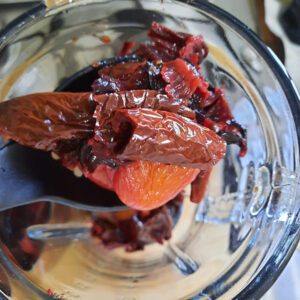
- Add 2 cups of the hibiscus-apricot soaking liquid, which should be a deep burgundy colour.
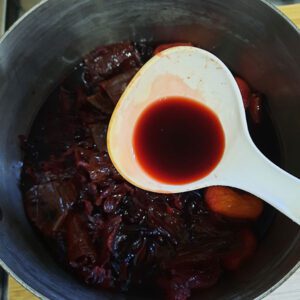
- Blend everything until you have a fairly smooth mix.

- Taste and add more sugar, lime juice or salt as necessary. You are going for a sweet, sour and salty flavour. You can also add more soaking liquid if you want your chamoy runnier. Blend again to mix.

- Transfer to a sterilised jar and keep in the fridge for up to a month.
